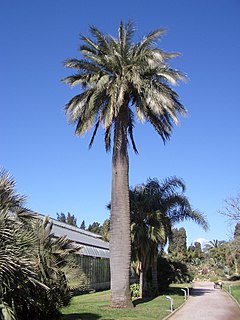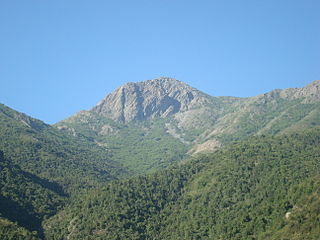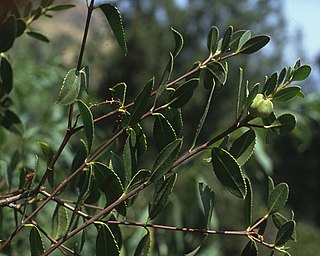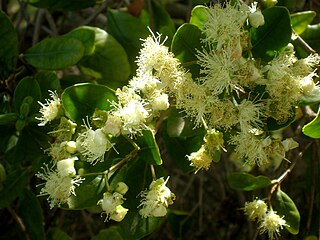
Avellanita is a monotypic plant genus of the family Euphorbiaceae. The sole species is Avellanita bustillosii, endemic to Chile. A specific locus of occurrence is in the La Campana National Park of central Chile and amid the adjoining Cerro La Campana and in Laguna Aculeo area and its southern distribution is located in Chancon, close to Rancagua.

Jubaea is a genus of palms with one species, Jubaea chilensis or Jubaea spectabilis, commonly known as the "Chilean wine palm" or "Chile cocopalm". It is native to southwestern South America and is endemic to a small area of central Chile between 32°S and 35°S in southern Coquimbo, Valparaíso, Santiago, O'Higgins, and northern Maule regions.

La Campana National Park is located in the Cordillera de la Costa, Quillota Province, in the Valparaíso Region of Chile. La Campana National Park and the Vizcachas Mountains lie northwest of Santiago. This national park covers approximately 80 square kilometres (31 sq mi) and is home to one of the last palm forests of Jubaea chilensis, which prehistorically had a much wider distribution than at present. Another attraction is the Cerro La Campana, which lends its name to the park. In 1834 Charles Darwin climbed this mountain, during the second voyage of HMS Beagle.

La Campana-Peñuelas is a Biosphere Reserve located in west-central Chile. which includes La Campana National Park and the Lago Peñuelas National Reserve. Forests within the La Campana-Peñuelas are habitats for the Chilean Wine Palm, Jubaea chilensis, an endangered palm, which had a much broader distribution prior to modern times.

Kageneckia oblonga is a species of plant in the family Rosaceae. It is endemic to Chile. K. oblonga is an evergreen tree. It grows from Coquimbo to Malleco. Example occurrences are found specifically found in central Chile within the La Campana National Park and Cerro La Campana forest areas. In these areas the endangered Chilean Wine Palm, Jubaea chilensis is an associated tree species.

Cerro la Campana, the Bell mountain, is a mountain in La Campana National Park in central Chile. The Pacific and the mountain Aconcagua are visible from the summit on clear days.
The Vizcachas Mountains is a mountain range northwest of Santiago, in the Santiago Metropolitan Region, Chile. It is part of the Chilean Coast Ranges System.
The Ocoa Valley is a landform in central Chile located by the La Campana National Park. This valley is a locus where considerable archaeological recovery has taken place, yielding considerable finds of pre-European contact period. According to Dallman and Hogan, some of the greatest stands of the endangered Chilean Wine Palm, Jubaea chilensis are found on the slopes of La Campana that rise up from the Ocoa Valley.
Adiantum gertrudis is a threatened species of ferns in the Vittarioideae subfamily of the Pteridaceae that occurs in central South America. One locus of occurrence of A. gertrudis is within central Chile at the La Campana National Park. A morphological trait unique to A. gertrudis is the hairs covering its fronds.

Puya venusta is a species in the Bromeliaceae family. This species is a rare plant found in certain portions of Chile including Punta Teatinos and Cerro La Campana. In La Campana National Park P. venusta is associated with the endangered Chilean Wine Palm, Jubaea chilensis, a palm that prehistorically had a significantly wider distribution.
Persea meyeniana is a species of evergreen tree belonging to the laurel family, Lauraceae. It belongs to the evergreen trees genus Persea of about 150 species.
Dasyphyllum excelsum is a species of flowering plant in the Asteraceae family. Known as Bulli in Chile. This plant is known to occur in parts of South America, in Chile it occurs from Quillota to Cauquenes between 190 and 800 m above sea level, a specific location of occurrence being in central Chile within the Cerro La Campana forests in association with the endangered Chilean Wine Palm, Jubaea chilensis.
Cuesta La Dormida is a mountain in central Chile. Some of the forested mountain area of Cuesta La Dormida has been added to the La Campana National Park in order to achieve protection for the Chilean Wine Palm and other endangered species. Forests on Cuesta La Dormida provide habitat for a number of bird and mammal species in addition to the flora mosaic itself.

Colliguaja odorifera is a lignotuberous species of the family Euphorbiaceae. Occurrence is in portions of South America, specifically in the Chilean matorral, where it can be found on both south and north-facing slopes. Each of these slopes have different air and soil moisture levels as well as different amounts of sunlight exposure, to which the shrub is able to adapt. Its specific occurrence is noted in central Chile in the La Campana National Park and Cerro La Campana areas, where this lignotuber is found in the same forest as the endangered Chilean Wine Palm, Jubaea chilensis.
Trevoa trinervis is a species of actinorhizal plant within the family Rhamnaceae; this dicotyledon flora is a shrub or small tree. The genus was first proposed by Miers in 1825, but was not fully described until 1830 by Sir William Jackson Hooker. T. trinervis is notable for its ability to fix nitrogen. This species mainly occurs in the near coastal forests and arid shrubland of Chile. Example occurrences are found in the mountains of central Chile; for example, it occurs in the La Campana National Park in association with Acacia caven and Jubaea chilensis. as well as other proximate areas of central Chile.
Satureja gillesii is a plant in the family Lamiaceae. Certain organic chemicals are derived from this species, which are useful to humans. S. gillesii occurs in parts of South America, one instance being in central Chile in the La Campana National Park area, in association with the endangered Chilean Wine Palm, Jubaea chilensis.
Adesmia resinosa is a species of flowering plant in the legume family, Fabaceae. It belongs to the sub-family Faboideae. The species is found in portions of South America, with an example location being La Campana National Park in central Chile as an understory associate of the Chilean wine palm.
Myrceugenia correifolia is a species of evergreen woody flowering shrub belonging to the Myrtle family, Myrtaceae. The common name of this plant is petrillo. The species is native to South America; an example occurrence is in central Chile within the La Campana National Park.

Myrceugenia exsucca is an evergreen woody flowering plant species of the Myrtle family, Myrtaceae. The species is native to South America as far south as Chile. An example occurrence is in central Chile within the La Campana National Park. A common name for this tree is petra.

Echinopsis chiloensis is a species of cacti native to South America; genus members are known as hedgehog cacti, sea-urchin cactus or Easter lily cactus. This species, E chiloensis, is tree-like with branching structures beginning basally. This plant can attain a height of eight metres. An example occurrence is within the La Campana National Park in Chile.












